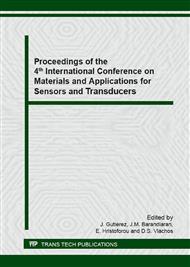p.163
p.167
p.171
p.175
p.179
p.181
p.185
p.189
p.196
C-Pd Films as Material for Optical Sensor of Hydrogen
Abstract:
Palladium nanograins placed in carbonaceous matrix shows many interesting properties connected to ability of hydrogen adsorption/absorption. Carbonaceous-palladium (C-Pd) films based on these materials change their structure and form, electrical conductivity, capacitance as well as optical absorption, transmission and reflection properties. These effects are connected to an incorporation of hydrogen atoms into palladium lattice [1], what change not only lattice constant [2] but also electric [3] and optical [4] properties of resulting material.
Info:
Periodical:
Pages:
179-180
Citation:
Online since:
May 2015
Authors:
Keywords:
Price:
Сopyright:
© 2015 Trans Tech Publications Ltd. All Rights Reserved
Share:
Citation:


